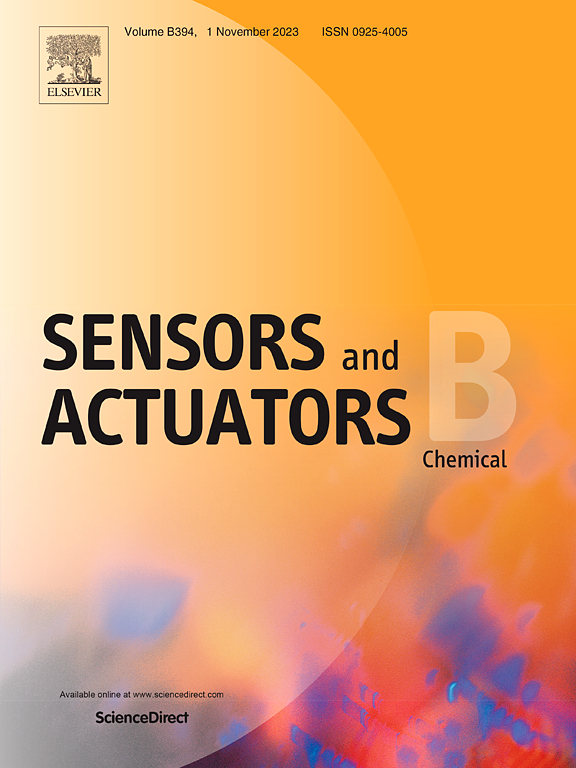酒石酸辅助合成WO3层叠相结及其丙酮气敏性能
IF 8
1区 化学
Q1 CHEMISTRY, ANALYTICAL
引用次数: 0
摘要
丙酮是一种可以直接影响人体重要器官的有害物质。准确的检测对于确保空气质量、监测环境和进行医疗诊断至关重要。本文采用简单的酒石酸辅助水热法合成了由纳米颗粒和纳米片组成的分层WO3相结。不同手性酒石酸(L(+)-酒石酸、D(-)-酒石酸、dl -酒石酸)的使用影响了WO3的形貌、物相和带隙。与L(+)-酒石酸、D(-)-酒石酸制备的样品相比,dl -酒石酸制备的分层WO3相结具有更高的暴露晶面,该结构的传感器在50 ppm丙酮下具有最高的响应(Ra/Rg=162.3)、较短的响应/恢复时间(16 s/15 s)和较低的实际检出限(300 ppb),工作温度为180℃。此外,它还具有良好的选择性、令人满意的重现性、稳定性和耐湿气性。利用原位漫反射红外傅立叶变换光谱(DRIFT)揭示了丙酮的反应过程,并通过密度泛函理论(DFT)计算进行了验证。这种增强的丙酮传感机制主要源于其独特的结构、窄的带隙、高暴露的晶面、相结和氧空位。这项工作为构建具有高气敏性能的分层WO3相结提供了一种新的设计方法。本文章由计算机程序翻译,如有差异,请以英文原文为准。

Tartaric acid-assisted synthesis and acetone gas sensing properties of hierarchical WO3 phase junctions
Acetone is a hazardous substance that can directly impact vital human organs. Accurate detection is crucial for ensuring air quality, monitoring the environment, and conducting medical diagnostics. Herein, hierarchical WO3 phase junctions assembled with nanoparticals and nanosheets were synthesized by a simple tartaric acid-assisted hydrothermal method. The morphology, phase, and band gap of WO3 are influenced by the use of different chiral tartaric acids (L(+)-tartaric acid, D(-)-tartaric acid, DL-tartaric acid). Compared with the sample prepared with L(+)-tartaric acid, D(-)-tartaric acid, hierarchical WO3 phase junctions prepared with DL-tartaric acid have the higher exposed crystal faces, and the sensor with this structure shows the highest response (Ra/Rg = 162.3), short response/recovery time (16 s/15 s) to 50 ppm acetone, along with low practical detection limit (300 ppb) at the operating temperature of 180 °C. Additionally, it possesses favorable selectivity, satisfactory reproducibility, stability, and resistance to moisture. The reaction process of acetone is revealed using in situ diffuse reflectance infrared fourier transform spectroscopy (DRIFT) and validated through density functional theory (DFT) calculations. Such enhanced acetone sensing mechanism mainly roots from its unique structure, the narrow band gap, high exposed crystal faces, phase junctions and oxygen vacancies. This work provides a novel design method to construct hierarchical WO3 phase junctions with high gas-sensing performance.
求助全文
通过发布文献求助,成功后即可免费获取论文全文。
去求助
来源期刊

Sensors and Actuators B: Chemical
工程技术-电化学
CiteScore
14.60
自引率
11.90%
发文量
1776
审稿时长
3.2 months
期刊介绍:
Sensors & Actuators, B: Chemical is an international journal focused on the research and development of chemical transducers. It covers chemical sensors and biosensors, chemical actuators, and analytical microsystems. The journal is interdisciplinary, aiming to publish original works showcasing substantial advancements beyond the current state of the art in these fields, with practical applicability to solving meaningful analytical problems. Review articles are accepted by invitation from an Editor of the journal.
 求助内容:
求助内容: 应助结果提醒方式:
应助结果提醒方式:


